Top Choices for a Fuel-Efficient Midsize Sedans
Choices are sometimes easy—like first class versus coach—or difficult—like the 20-page menu at a restaurant that makes your head spin. Then, there is Kia, which presents us with two good options.
Kia gives fuel-conscious, midsize sedan buyers two choices with the 2017 Optima Hybrid and Optima PHEV (Plug-in Hybrid Electric Vehicle). Both are worthy to be in your garage, but are different enough to take a closer look as one may be better than the other for your driving pattern and lifestyle.
Drivetrains
Both models are front-wheel drive with 2.0-liter, four-cylinder DOHC (double overhead cam) engines, mated to six-speed automatics and using regular fuel. The engines put out 154 horsepower and 140 pounds-feet of torque and promise similar EPA fuel economy ratings—the hybrid gets 39 mpg city/46 highway/42 combined, and the PHEV 38 city/43 highway/40 combined. So far so good, as you would not be disappointed owning either car as far as fuel economy is concerned.
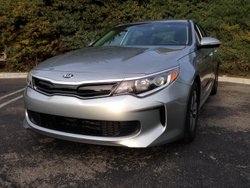
But here is the big difference between the two: the PHEV has an all-electric range (AER) of 29 miles and a 103 MPGe (miles per gallon equivalent). The AER may seem low at 29 miles, but Kia has a neat little secret of a generator to replenish the AER battery while you are driving in gasoline mode. It turns off hybrid mode (where the engine computer selects whether to use the gas engine, electric motor or a combination of the two) and directs engine energy to recharge the battery.
Keeping the AER charged to maximum allows you to not use the less-efficient gasoline engine when driving around town or stuck in bumper-to-bumper traffic. You need to manually place the car in pure EV mode, but once there, you zip around with good torque and power in silence. For a bit of fun, you can go up to 75 mph on electricity where the only sounds you hear are the tires on the road.
So, depending on how much city driving you do, your need for gasoline could be very, very low. With the AER able to be topped-off at all times, you just might experience the 600 miles of total driving range estimated by Kia. Yes, that is San Diego to San Francisco with one hundred miles to spare. If you decided to cruise over the Golden Gate Bridge and visit the Napa or Sonoma Valley for some wine tasting, you would still have driving distance remaining.
Driving Experience: On the Road
Clean Fleet Report was driving the 2017 Kia Optima Hybrid Premium that weighed in at 3,486 lbs., while the Optima PHEV which added 302 pounds, two-thirds of that coming from its larger battery. Both cars, with electric power-assisted rack and pinion steering, handled corners well, but not exciting. In all fairness to Kia,
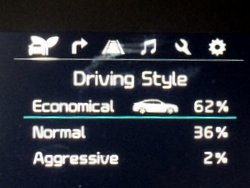
the Optima is not marketed as a sports sedan, so the handling in that case was just fine. The overall ride comfort and quietness was excellent in the Optima PHEV, and it had a bit better cornering grip than the Optima Hybrid. This would be attributed to the added weight of the PHEV and the 17-inch tires and wheels versus the 16-inchers on the Hybrid.
Stopping was straight and true with no fading from the power-assisted front ventilated and rear solid disc brakes, with four-wheel anti-lock brake system (ABS) and brake assist.
Common on all hybrids is a regenerative braking system. Kia’s is a key part of the recharging of the Optima’s Lithium-ion polymer battery. Regenerative braking converts braking or coasting into electricity, which charges the battery. You will come to enjoy monitoring the battery charge and mileage range (metered instantly with dash gauges) when driving around town, stuck in stop-and-go rush hour traffic, or coasting down hills.
Driving Experience: Exterior
Kia has received wide praise and acknowledgment of the Optima’s design, which they say has “European styling…delivering a class-up experience.†The 2017 Kia Optima Hybrid
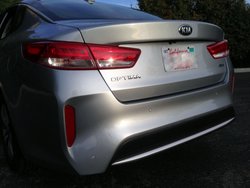
exterior design is differentiated from the gasoline versions, but still retains its 0.24 Cd, which equals the Tesla Model S. The front end has active grille shutters and an air curtain, while the rear has a diffuser to maximize airflow. Even the wheels have a hybrid-specific aerodynamic design.
The Optima has wrap-around, projection headlights (LED with dynamic bending on our PHEV model) that extend wide on the fenders. The roofline has a sports coupe look with a raked A-pillar and long swept-back C-pillar leading to a raised deck lid, capped-off with a subtle integrated lip. Finishing off the rear are narrow, down-and-inward angled LED tail lights that start midway through the rear fender and end on the trunk lid. Kia even hid the exhaust tips, which are concealed by the rear diffuser.
Driving Experience: Interior
Clean Fleet Report was driving two different, but similarly equipped Optima Hybrid models. One had the Convenience Package and the other with the EX Technology Package. Both packages made the interiors a comfortable place to spend lengthy, fuel-efficient road trips. We were very impressed and a little surprised with the EX Technology Package (a $5,250 additional charge) that had everything a higher-end luxury car would have as an option.
First and foremost, Kia has spent time making the driving experience one of convenience and comfort. The cockpit layout is simple and clean with soft touch materials on the dash and door panels. The easy to find and read cruise control, telephone and audio controls are housed on the leather-wrapped steering wheel. I was especially pleased to see the radio had on/off knobs for volume and channel selection, and the climate control wheels were a different size than those of the radio. This may not seem like a big thing, but it is when reaching for these very different controls in the dark—regardless of your familiarity with the dash layout.

The simplicity of the dash layout made reading the gauges easy. The Optima PHEV with the EX Technology Package came with an eight-inch LCD touch screen for navigation and the rear view camera display. A great sounding Harman Kardon QLS premium surround sound system came with SiriusXM (three-month trial subscription) and an AM/FM/HD/CD/MP3 radio with Apple CarPlay, Android Auto and Siri Eyes-free. You also get USB ports, iPod connectivity, Aux-in jacks, Bluetooth streaming audio and hands-free telephone. All of this technology is controlled through the UVO Infotainment and Connectivity Platform, which is unique to Kia.
The list of convenience features is what would be expected (when paying more than five grand for an optional package) and Kia does not disappoint. You get power everything and leather everywhere. The very comfortable heated and ventilated front leather seats (with tasteful hand stitching) are power for the driver and passenger, with the driver getting power lumbar adjustments as well. Even the rear outbound seats are heated. The power panoramic sunroof brings the skies into the cabin.
Safety and Convenience
Clean Fleet Report’s 2017 Kia Optima Hybrid and PHEV models came with safety and convenience features including seven air bags, remote keyless entry, tire pressure monitoring system, push button start, electronic stability control, traction control, vehicle stability management, hill start assist, projector beam headlights, blind spot detection, rear cross traffic alert, rear parking assist, anti-theft engine immobilizer and ABS mentioned earlier.
In crash testing by the National Highway Traffic Safety Administration (NHTSA) the 2017 Kia Optima Hybrid has an Overall 5-Star rating (their Top Rating), while the Insurance Institute for Highway Safety (IIHS) gave the 2017 Optima Hybrid its highest rating of a Top Safety Pick. Note: the Optima PHEV was not rated separately by either organization.
Pricing and Warranties
2017 Kia Optima Hybrid Premium
$25,995 Base Price
$27,790 As tested, with options
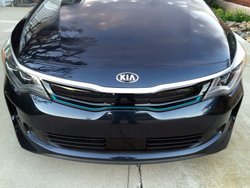
————————————-
2017 Kia Optima Hybrid PHEV
$35,210 Base Price
$40,510 As tested, with options
All prices exclude the $895 freight and handling charge.
The 2017 Kia Optima Hybrids come with these warranties:
- Battery – 10 years/150,000 miles (CA, OR, WA, NY)
- Battery – 10 years/100,000 miles (remaining states)
- Basic – Five years/60,000 miles
- Powertrain – 10 years/100,000 miles
- Roadside Assistance – Five years/60,000 miles
Observations: 2017 Kia Optima Hybrid & Optima Plug-in Hybrid
If an auto manufacturer doesn’t have a hybrid, PHEV, EV or fuel cell in their line-up by now, they had better do so real soon. The electrification of automobiles (buses, trucks and tractors too) is here and is only growing. High fuel economy and clean air is not a trend or pipe dream, but a reality.
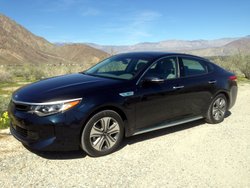
The two Kia Optima models reviewed here are part of the company’s hybrid family that is among the best on the market. And, if you are looking for a plug-in hybrid with an onboard battery charger, only Audi/Porsche and Kia’s sister company Hyundai offers the same technology.
So what makes a PHEV worth the extra expense over a conventional hybrid? Driving range and increased fuel economy.
Having driven hybrids from several manufacturers, the Kia hybrids offer a good compromise of excellent fuel economy and performance/ride dynamics. The smooth operation and seamless transition between gasoline and electric drive in the refined hybrid powertrain makes it a pleasure to drive.
The big selling point, though, is the onboard generator, where Kia has provided consumers an impressive all-electric driving range. By a simple push of a button, the generator quietly turns on and the AER will, in theory, never run out. Being able to travel 600+ miles in a comfortable, midsize sedan is remarkable. The EPA says the Optima PHEV gets 103 MPGe, which is easily reached—or exceeded—under normal driving conditions. Oh, and don’t forget that in many states owning a plug-in electric car qualifies you for a coveted HOV lane sticker and will let you get into city centers where gasoline powered cars are banned.
This might be the time to broaden your vehicle consideration list to include a Kia Optima PHEV. You will have to balance cost versus your driving pattern to see if it makes sense. If it does, sit back and enjoy a comfortable, fuel-sipping ride for years to come.
Whatever you buy, Happy Driving!
Related Stories You Might Enjoy:
Road Test: 2017 Hyundai Sonata Plug-in Hybrid
Road Test: 2017 Ford Fusion Energi Plug-in Hybrid
News: 2017 Geneva Motor Show: More Plug-ins Are Coming
Road Test: 2016 Hyundai Sonata Hybrid
Disclosure:
Clean Fleet Report is loaned free test vehicles from automakers to evaluate, typically for a week at a time. Our road tests are based on this one-week drive of a new vehicle. Because of this we don’t address issues such as long-term reliability or total cost of ownership. In addition we are often invited to manufacturer events highlighting new vehicles or technology. As part of these events we may be offered free transportation, lodging or meals. We do our best to present our unvarnished evaluations of vehicles and news irrespective of these inducements.
Our focus is on vehicles that offer the best fuel economy in their class. We also feature those that are among the top mpg vehicles in their class. In addition, we aim to offer reviews and news on advanced technology and the alternative fuel vehicle market. We welcome any feedback from vehicle owners and are dedicated to providing a forum for alternative viewpoints. Please let us know your views at publisher@cleanfleetreport.com.

10 thoughts on “Comparison Test: 2017 Kia Optima Hybrid and Plug-in Hybrid”